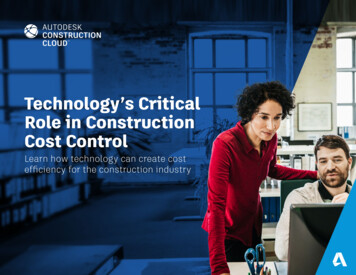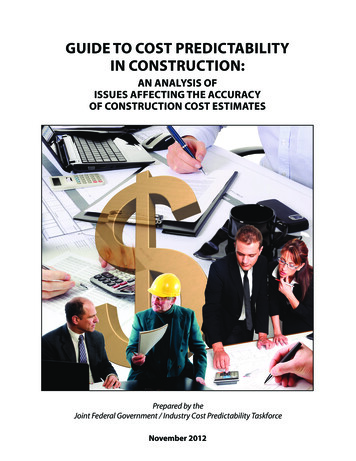
Transcription
Construction CostManagementIn the last decade, following the Latham and Egan reports, there have been many significantchanges in the role of the construction cost manager. Keith Potts examines the key issues andbest practice in the cost management of construction projects under traditional contracts andnew methodologies. All stages within the life cycle of a project are considered from pre-contractto tendering and post-contract.Worked examples, legal cases and over 65 project case studies are used to illustrate thepractical application of the theory, where appropriate. Extensive references are captured,including the UK government’s Constructing Excellence programme and the National AuditReports, in order to further develop an understanding of the subject. Reference is made to majorprojects such as the Scottish Parliament Building, Wembley Stadium and BAA’s HeathrowTerminal 5.Aimed at students of Surveying and Construction Management programmes, this bookuniquely embraces cost management in both the building and civil engineering sectors in theUK and overseas and should thus prove useful to practitioners. Seminar questions are includedat the end of each chapter with additional links to over 100 project case studies in order toreinforce the learning experience.Keith Potts is Senior Lecturer in the School of Engineering and the Built Environment at theUniversity of Wolverhampton. He is a RICS external examiner in Quantity Surveying, and AwardLeader of the RICS-accredited MSc in Construction Project Management.
Also available from Taylor & FrancisConstruction EconomicsDanny MyersPrinciples of Project and Infrastructure FinanceWillie TanConstruction Project ManagementPeter FewingsNew Generation Whole-Life CostingIan Ellingham and William FawcettHb: ISBN 9780415286138Pb: ISBN 9780415286398Hb: ISBN 9780415415767Pb: ISBN 9780415415774Hb: ISBN 9780415359054Pb: ISBN 9780415359061Hb: ISBN 9780415346573Pb: ISBN 9780415346580Information and ordering detailsFor price availability and ordering visit our website www.tandf.co.uk/builtenvironmentAlternatively our books are available from all good bookshops.
Construction CostManagementLearning from case studiesKeith Potts
First published 2008by Taylor & Francis2 Park Square, Milton Park, Abingdon, Oxon OX14 4RNSimultaneously published in the USA and Canadaby Taylor & Francis270 Madison Ave, New York, NY 10016Taylor & Francis is an imprint of the Taylor & Francis Group,an informa businessThis edition published in the Taylor & Francis e-Library, 2008.“To purchase your own copy of this or any of Taylor & Francis or Routledge’scollection of thousands of eBooks please go to www.eBookstore.tandf.co.uk.” 2008 Keith PottsAll rights reserved. No part of this book may be reprinted orreproduced or utilised in any form or by any electronic,mechanical, or other means, now known or hereafterinvented, including photocopying and recording, or in anyinformation storage or retrieval system, without permission inwriting from the publishers.The publisher makes no representation, express or implied, with regardto the accuracy of the information contained in this book and cannotaccept any legal responsibility or liability for any efforts or omissionsthat may be made.British Library Cataloguing in Publication DataA catalogue record for this book is available from the British LibraryLibrary of Congress Cataloging in Publication DataPotts, Keith F.Construction cost management: learning from case studies /Keith Potts.p. cm.Includes bibliographical references and index.1. Construction industry – Costs.2. Construction industry – Cost control. I. Title.TA682.26.P68 2008624.068’1–dc22ISBN 0-203-93301-X Master e-book ISBNISBN10: 0–415–44286–9 (hbk)ISBN10: 0–415–44287–7 (pbk)ISBN10: 0–203–93301–X (ebk)ISBN13: 978–0–415–44286–2 (hbk)ISBN13: 978–0–415–44287–9 (pbk)ISBN13: 978–0–203–93301–5 (ebk)2007032917
This book is dedicated to the memory of Francis Leon Potts,who first encouraged me to go into quantity surveying, and tothe love and friendship of Lesley, Ian, Gemma and Debbie.
ContentsPrefacexiiiPart I Introduction1 Introduction and tting the scene 3Construction overview 3Influential reports 5Recommendations from professional bodies 6Learning from case studies 7Learning from project failures 10Relevant observation 11Conclusion 11Questions 12Bibliography 122 Reports and ction 14The Latham report, Constructing the Team (1994) 15Levene Efficiency Scrutiny (1995) 17Construction Procurement Guidance, HM Treasury (1996) 17Construction Industry Board (CIB) working groups (1996–1997) 19The Egan report Rethinking Construction (1998) 20Modernising Construction, National Audit Office (2001) 22The second Egan report, Accelerating Change (2002) 23Achieving Excellence in Construction Procurement Guides, Office ofGovernment Commerce (2003) 24Improving Public Services through Better Construction, NationalAudit Office (2005) 24Conclusion 25Questions 25Bibliography 2614
viiiContentsPart II Management of the pre-contract stage3 Selecting the consultants and contractors3.13.23.33.43.53.63.73.859Introduction 59Structure of BOT projects 60Case study: Nottingham Express Transit (NET) Light Rail 60Factors leading to success on BOT projects 62Risks and securities 62Case study: Sydney SuperDome, Australia 63The Private Finance Initiative (PFI) 64The role of the cost consultant in PFI/PPP projects 69Case study: Stoke-on-Trent Schools, UK 70Conclusion 72Questions 72Bibliography 736 Contractor’s estimating and tendering6.16.26.36.46.56.66.746Introduction 46Cost estimating on engineering, manufacturing and process industries 47Cost estimating on civil engineering projects 49Cost estimating on building projects 52General comments 57Action after receipt of tenders 57Conclusion 57Questions 58Bibliography 585 Cost management on PFI duction 29Selecting consultants 30Selecting contractors by value 34Construction Industry Research and Information Association(CIRIA) Guide – Selecting Contractors by Value 39Two-stage tendering 41FIDIC tendering procedures 41Conclusion 44Questions 44Bibliography 454 Pre-contract cost management4.14.24.34.44.54.64.74.827Introduction 75Stage 1 – decision to tender 77Stage 2 – determining the basis of the tender 77Stage 3 – preparation of cost estimate 79Stage 4 – commercial appreciation 84Stage 5 – conversion of estimate to tender 85Stage 6 – submission of tender 8675
Contents6.86.9Conclusion 86Questions 86Bibliography 87Part III Key tools and techniques7 Value ction 122Understanding the relevance of whole-life costing (WLC) 123The basic steps in whole-life costing (WLC) 123Money, time and investment 125Calculations 127Problems with assessing whole-life costs 129Whole-life value (WLV) 129Conclusion 130Questions 130Bibliography 131Part IV Procurement strategies10 Organizational methods (part A)10.110.291Introduction 105Risk identification 106Risk analysis techniques 108Risk register 114Risk response 114Strategic risk management 116Case studies 118Conclusion 119Questions 120Bibliography 1209 Whole-life costing9.19.29.39.49.59.69.79.89.989Introduction 91What is value management? 91Value planning (VP) 93Metropolis United’s new football stadium 94Value engineering (VE) 97Value reviewing (VR) 98Case studies 99Conclusion 103Questions 103Bibliography 1038 Risk management (RM)8.18.28.38.48.58.68.78.88.9ixIntroduction 135Traditional method 137133135
xContents10.310.410.510.610.710.810.9Design and build 140Turnkey 146Joint ventures 147Consortium 149Partnering 149Conclusion 155Questions 155Bibliography 15511 Organizational methods (part .1211.1311.1411.15Introduction: management methods 157Management contracting 158Construction management 161Management contracting or construction management? 165Reflections on the Scottish Parliament building 165Design and manage 167EC procurement rules 168Achieving Excellence in Construction 168The NHS Procure 21 guidelines 170Highways Agency – overlying principles for future procurement 171The 2012 London Olympics 172Selecting the procurement route 173Achieving Excellence in Construction methodology 174Conclusion 174Questions 176Bibliography 17612 Payment systems and contract 12.1012.11178Introduction 178Price-based, lump-sum plan and specification 179Price-based, bills of quantities (BofQ) 180Operational bills 183Price-based, method-related bills 184Price-based bills of quantities (BofQ) with milestone payments 184Price-based activity schedules 186Cost-based, cost-reimbursement contracts 188Cost-based, target-cost contracts 189Conclusion 192Questions 193Bibliography 193Part V Management of the post-contract stage13 Contractors’ cost-control and monitoring procedures13.113.213.313.4157Introduction 197Developing a cost-control system 198Method 1: cost-value reconciliation (CVR) 199Method 2: contract variance – unit costing 203195197
Contents13.513.613.7Method 3: earned value analysis 206Conclusion 207Question 209Bibliography 20914 Change management – valuing ntroduction 227Terms in contract conditions 228Legal requirements of claims submission 229Contractor’s programme 231Concurrent delays 231Proving the delay 233Disruption 234Progress records 234Claims presentation 235Quantifying the claim 236Conclusion 240Some legal cases 240Questions 242Bibliography 243Part VI Contracts and case study16 The NEC Engineering and Construction ction 211Contractual requirements – ICE Conditions of Contract, 7th edition,January 2003 212Contractual requirements – JCT Standard Building Contract with Quantities(SBC/Q 2005 edition) 213Contractual requirements – The NEC Engineering and ConstructionContract, 3rd edition 214Fixing the rate 215Quantum meruit claims 219Some other relevant legal cases (reported in date order) 221Conclusion 225Questions 225Bibliography 22615 Claims 015.1115.1215.13xiIntroduction 247The NEC family of contracts 247Objectives of the NEC 248Design principles 250Core clauses 252Secondary options 254ECC tender documents 255Conclusion 256245247
xiiContents16.9Question 257Bibliography 25717 FIDIC standard forms of international construction 7.1117.1217.1317.14Introduction 258The new forms 258Balance of risk 260Structure of the new Red Book 260The employer (clause 2) 261The engineer (clause 3) 262The contractor (clause 4) 263Commencement, delays and suspension (clause 8) 265Measurement and evaluation (clause 12) 269Variations and adjustments (clause 13) 271Contract price and payments (clause 14) 275Claims, dispute and arbitration (clause 20) 278Conclusion 278Questions 279Acknowledgements 279Bibliography 27918 Case study: Heathrow Terminal 281Introduction 281Project management philosophy 282T5 Agreement 283The approval process 285Controlling the time, cost and quality 286Logistics 287The 3D project model 288The use of the NEC 288Role of the cost consultants 289Lessons learned 290Conclusion 291Bibliography 292Table of casesIndex293295
PrefaceMy first text book Major Construction Works: Contractual and Financial Management(Longman) (1995) was based on documentation assembled during 1993 and 1994; this nowseems like a prehistoric era before the Latham (1994) and Egan (1998) reports!In that book, I attempted to identify the key issues in the successful contractual and financialmanagement on major projects. It was based on my experience as a senior quantity surveyor, atseparate times employed by both contractor and client, on the Hong Kong Mass Transit Railway –at the time one of the largest construction projects in the world. In contrast to the norm at thattime within the UK, the massive Hong Kong project – despite major difficulties – was completedon time and within budget. The lessons to be learned from this project were identified in thecase study in the last chapter of the book. It was clear from this experience that any projectcould be completed on time and within budget providing the appropriate procurement systems,planning and control methods, contracts and financial procedures were in place – crucially withexperienced, motivated people to implement them.Over a decade later, the world seems very different, yet the same fundamentals apply –clients wish to obtain their project within budget and within time and to the necessary quality.The relentless growth of the World Wide Web (www) meant that all could now easily accessa vast array of important information. The problem for students, however, was in identifyingwhich information was significant and which was superfluous.In this new text, I have attempted to embrace the recommendations of the key reports andgovernment bodies including the National Audit Office and the Office of GovernmentCommerce. The book includes the tools and techniques required under the newpartnering/alliancing philosophies as well as including chapters on valuing variations and claimsbased on the traditional procurement approach. Observations in the book are reinforcedthroughout with detailed analysis of over 60 project case studies with additional links to over100 case studies. Many of the project case studies are taken from the Building magazine or theNational Audit Office reports to whom the author is most grateful for permission to publish.A chapter is included on the NEC ECC Contract, which has been the standard contract in thecivil engineering and infrastructure sectors for some time and is increasingly chosen by publicclients in the building sector. Its choice by the London 2012 Olympic Development Authorityreinforces its status. A chapter on the new FIDIC contract is included for those working on majorprojects outside the UK. Uniquely, the new textbook embraces both the building and civilengineering sectors and should be of interest to both undergraduate and postgraduate studentsas well as practitioners.
xivPrefaceA significant case study on the Heathrow Terminal 5 has been included. It is important thatthe lessons learned on this pioneering project in lean-construction are disseminated andunderstood by all.Over the past two years I have received useful information from many senior quantitysurveyors and commercial managers representing both consultants, public and private clientsand contractors. These together with comments and observations received from undergraduateand postgraduate students at the University of Wolverhampton have deeply enriched the study.Finally, I wish to thank fellow colleagues Rod Gameson, Chris Williams and particularly PaulineCorbett for their valued help in passing learned comments on the draft chapters. Any errors oromissions are, of course, my responsibility.
Part IIntroduction
1 Introduction andoverview1.1 Setting the sceneThere have been many significant changes in the construction sector within the past decade.The relentless development of computer power and the growth of the World Wide Web andknowledge management, the increasing use of Private Finance Initiative (PFI) and Public–PrivatePartnership (PPP), the growth of partnering and alliancing, the increasing importance of supplychain management and the increasing use of the New Engineering Contract have changed theindustry for the good. Yet, the same fundamentals apply – clients wish to obtain their projectwithin budget and within time and to the necessary quality.Significantly, the role of the quantity surveyor (QS) has also changed and many have movedon from contractual and financial management of projects to embrace the key role as the client’sconstruction manager/project manager. One of the pioneer QS construction project managerswas Francis Graves, who undertook the task of project controller in 1972 on the massivefive-year-long Birmingham NEC Exhibition Centre project. He considered his terms of referenceon this project very straightforward – Get it finished on time and get value for money!An analysis of three of the top QS Consultants’ websites shows their involvement in a widerange of cost management and related services (Table 1.1).Significantly, following their successful partnership on the Heathrow Terminal 5 project, ECHarris and Turner & Townsend established Nuclear JV to tender for programme controls servicesand to subsequently target the wider nuclear decommissioning programme. Of particularinterest, Rob Smith, Chairman of Davis Langdon & Seah, in his introduction to their 2005–2006Global Review identifies some of the big issues facing us all – particularly environmental andsustainability concerns. He comments that part of Davis Langdon’s contribution will be the introduction of sustainable design thinking and sustainable metrics into their cost plans (www.davislangdon.com/mainpage/GlobalReview.htm. [accessed 28 February 2007]).1.2 Construction overviewThe construction sector is strategically important for Europe, providing the infrastructure andbuildings on which all sectors of the economy depend. With 11.8 million operatives directlyemployed in the sector, it is Europe’s largest industrial employer accounting for 7% of totalemployment and 28% of industrial employment in the EU. It is estimated that 26 millionworkers in the EU depend in one way or another on the construction sector. About 910 billion
4IntroductionTable 1.1 Range of services offered by leading construction cost consultants.CompanyCost management servicesEC HarrisConsulting: Asset & Facilities Strategies; Enabling Technology & ManagementInformation Systems; Performance Management; Technical & Investment RiskManagement; Public Private Finance Consultancy; Supply-Chain Management;Risk Management & Business ContinuityManaging Delivery: Programme, Project & Construction Management; CommercialManagement, Quantity Surveying & Value Engineering; Safety, Health &Environmental Management; Asset & Facilities Management; IndependentAdvisor, Due Diligence & Insolvency; Strategic Procurement, Contractual Advice &Dispute Resolution; Development ManagementDelivery of Business Support Maintenance & Construction: Facilities Outsourcing;Prime ContractingInception: Feasibility Studies; Business Case; Development; Strategic Cost Planning;BenchmarkingDevelopment: Contract Strategies; Option Appraisals; Capital and Operational CostPlanning; Risk Management; Value Management; Whole-Life Costing; Supplier &Contractor ProcurementImplementation: Cost Control & Management; Change Control; PaymentMechanisms; Performance MeasurementOperation and Occupation: Maintenance Strategies; Energy and Cost-in-UseAnalysis; Facilities ManagementBenchmarkingEmployer’s AgentBills of QuantitiesFeasibility StudiesBuilding Services (M&E)Project AuditsCapital AllowancesQuantity Surveying/Cost CommercialManagementReal Estate Due DiligenceContract Advisory ServicesReal Estate Tax ManagementContract DocumentationWhole-Life Costing AnalysisCost Modelling and PlanningDue DiligenceTurner & TownsendFranklin AndrewsSource: Websites www.echarris.com; www.turnerandtownsend.com; www.franklinandrews.com (accessed 28 February 2007).was invested in construction in 2003, representing 10% of the GDP and 51.2% of the GrossFixed Capital Formation of the EU (www europa.eu.int [accessed September 2006]).Moreover, the relationship between construction activities and the built environment, on theone hand, and sustainable development, on the other, is both significant and complex.Construction uses more raw materials than any other sector, and the creation and operation ofthe built environment accounts for an important consumption of natural resources. There is alsoa pressing need to address the regeneration of many urban areas of Europe, in particular in thenewly acceded countries, and the realization of major trans-European infrastructure works.The UK construction activity makes a considerable contribution to the national economyaccounting for over 8% of the national gross domestic product. UK annual public sector construction output has grown by over a third between 1999 and 2003 from just under 24 billionper year to around 33.5 billion, and capital investment is set to continue expanding over thenext three years in key sectors such as schools, hospitals, roads and social housing (NAO, 2005).Table 1.2 shows the top ten clients/promoters by turnover from 1 January 2006 to 31December 2006 in the UK based on analysis of contracts with a value of 100,000 or above,and all work awarded by negotiation or competitive tender, including residential and civil work.Significantly, these major clients have shown the lead in embracing the new procurement routesand conditions of contract.
Introduction and overview5Table 1.2 Top clients/promoters in the UK – year ending 31 December 2006.CompanyTotal value( million)Main procurement type1 British Nuclear Fuels6,5062 Partnership for Schools4,0003 Defence Estates3,1604 Birmingham Council2,3105 Olympic Delivery Authority1,565Framework agreementsCompetitive supply chainsFixed price or Target cost contracts (when scope andrisk reasonably defined)Long-term partnershipsPrivate Finance InitiativesDesign and build contractsPrime contractingPublic–Private Partnerships/Private Finance Initiatives500 million 5-year Partnership with 3construction companies for all projectsvalued at more than 100,000Contracts based on NEC3Based on OGC’s Achieving Excellence inConstruction GuidesProjects managed using a delivery partnerContracts based on NEC3Source: Developed based on Building magazine, 26 January 2007, p. 20 and websites: www.britishnucleargroup.com;www.p4s.org.uk/; www.defence-estates.mod.uk/major projects/ index.htm; www.birmingham.gov.uk; www.london2012.com (accessed 1 March 2007).1.3 Influential reportsIn the last 60 years there have been numerous reports on the state of the UK construction industry(Murray and Langford, 2003), including the following: Placing and Management of Building Contracts: The Simon Committee Report (1944);The Working Party Report to the Minister of Works: The Phillips Report on Building(1948–1950);Survey of Problems before the Construction Industry: A Report Prepared by Sir HaroldEmmerson (1962);The Placing and Management of Contracts for Building and Civil Engineering Work: TheBanwell Report (1964);Tavistock Studies into the Building Industry: Communications in the Building Industry (1965)and Interdependence and Uncertainty (1996);Large Industrial Sites Report (1970);The Public Client and the Construction Industries: The Wood Report (1975);Faster Building for Industry: NEDO (1983);Faster Building for Commerce (1988).With the exception of the Tavistock Studies, these were all government-sponsored reports,produced by large committees. Most made recommendations for improvement but were mainlyignored due to poor client involvement and no follow-up legislation to reinforce their findings.Significantly, Banwell (1964) recommended that a common form of contract be used for allconstruction work. This only started to become a reality 30 years later – with the introductionof the New Engineering Contract (NEC).
6IntroductionThankfully, Sir Michael Latham’s Constructing the Team (1994) was not ignored, being thecatalyst, which has attempted to transform the industry. Since this date we have seen thepublication of many significant government-sponsored or National Audit Office Reportsincluding The Egan report Rethinking Construction (1998); Modernising Construction (2001);The Second Egan report Accelerating Change (2002); Achieving Excellence in ConstructionProcurement Guides (2004) and Improving Public Services through Better Construction (2005).These reports and other relevant key recommendations are reviewed in Chapter 2 in orderthat best practice be identified.1.4 Recommendations from professional bodiesThe RICS APC/ATC requirements and competencies (RICS, 2002)The RICS identifies that construction surveyors (quantity surveyors) may be working asconsultants or working for a contracting or engineering company in the following areas: Preparing development appraisals for different sites, assessing the effects of capital andrevenue expenditure, life-cycle costs, grants and taxation implications;Advising clients on the project brief, preferred procurement routes, costs and cash flow;Analysing the whole-life costs of a project;Planning the construction process;Monitoring and control of cost during the pre-contract stages;Preparing tender and contractual documentation, leading to tender selection andappraisal;Following the letting of the contract for the project, advising on payments to contractorsand post-contract cost control, settlement of final account;Controlling a project on behalf of their employer;Negotiating with the client or subcontractors;Reporting on programme and financial matters;Risk and value management (RM and VM);Giving contractual advice for either party in the case of dispute.It is noted that new guidelines for the Assessment of Professional Competence were issued bythe RICS in July 2006 (www.rics.org.uk [accessed 26 April 2007]).The Construction Industry CouncilThe Council (representing all the professions) in their publication Project Management Skills inthe Construction Industry (2002) identified the key skills for those operating in construction project management under the following headings:Strategic: strategic planning/VM/RM/quality management;Project control: the project-control cycle/developing a schedule/monitoring/managing change/action planning/client/project interface/information management;Technical: design management/estimating/value engineering (VE)/modelling and testing/configuration management;Commercial: business case/marketing and sales/financial management/procurement/legal issues;Organization and people: organization structure/selection of a project team/people issues.
Introduction and overview7The CIOB Code of Practice for Project Management forConstruction and DevelopmentThis is a significant source of knowledge with a third edition published in 2002. This CIOBinitiative involved the formation of a multi-institute task force; the 1991 first edition was referredto by Sir Michael Latham in his report Constructing the Team (1994) as an example of cooperationbetween the professions.The Association for Project Management’s Body of Knowledge,5th edition (APM, 2006)This generic guideline for project management identifies the behavioural characteristics, theknowledge areas and competencies that are desirable for professionals in project management.It is the UK vision of generic project management within guidelines set by the InternationalProject Management Association.APM Body of Knowledge: key topics are listed belowSection 1 – project management in context: project management, programme management,portfolio management, project context, project sponsorship, project office;Section 2 – planning the strategy: project success and benefits management, stakeholdersmanagement, VM, project management plan, project RM, project quality management,health and safety and environmental management;Section 3 – executing the strategy: scope management, scheduling, resource management,budgeting and cost management, change control, earned VM, information management andreporting, issue management;Section 4 – techniques: requirements management, development, estimating, technologymanagement, VE, modelling and testing, configuration management;Section 5 – business and commercial: business case, marketing and sales, project finance andfunding, procurement, legal awareness;Section 6 – organizational and governance: project life cycles, concept, definition, implementation, hand-over and close out, project reviews, organizational structure, organization roles,methods and procedures, governance of project management;Section 7 – people and the profession: communication, teamwork, leadership, conflictmanagement, negotiation, human resource management, behaviour characteristics, learningand development, professionalism and ethics.1.5 Learning from case studiesSome projects become iconic, reflecting the challenge of the new and the time and place. TheSydney Opera House in Australia became the symbol for the Millennium Olympics in 2000 andsomehow reflected the healthy swagger of the emerging continent. The competition for theproject was won in 1957 by Danish architect Jorn Utzon, whose first design according to themembers of jury was hardly more than a few splendid line drawings. This comment could alsohave been made many years later in connection with Enric Miralles’ first submission on theScottish Parliament building.The billowing concrete sailed roof had never been built before. It should therefore have beenno surprise that the A 7 million project escalated to over A 100 million and the plannedconstruction period of 5 years was finally extended to 14 years (1959–1973). The architect
8Introductionwas put under so much pressure over the escalating costs that he left the project half-waythrough after which his designs were modified. As a result, the building is perfect for rock concertsbut not suitable for staging classical full-scale operas (Reichold, K. and Graf, B., 1999).Another iconic building is the Centre Pompidou in Paris, a building famous for being insideout with all the structural frame, service ducts and escalators being on the outside allowing aflexible floor space within. The audacious steel and glass National Centre for Art and Culturewas designed by two young unknown architects Renzo Piano and Richard Rogers, to last – asGeorge Pompidou reminded architects – for fo
4.2 Cost estimating on engineering, manufacturing and process industries 47 4.3 Cost estimating on civil engineering projects 49 4.4 Cost estimating on building projects 52 4.5 General comments 57 4.6 Action after receipt of tenders 57 4.7 Conclusion 57 4.8 Questions 58 Bibliography 58











